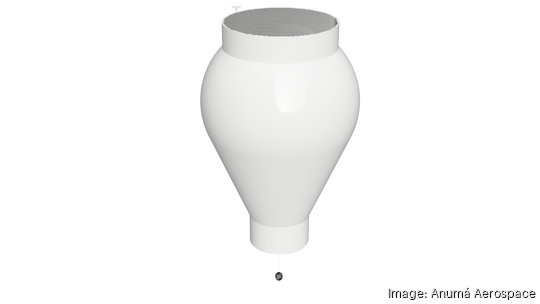
Imagine vacuum-powered cargo airships zooming overhead, with zero carbon emissions, replacing trucks on the highway and airplanes in the sky. It’s the vision of a tiny Research Triangle Park startup, working to build solar-electric, partial-vacuum lift airships capable of vertical takeoff and landing.
Called Anumá Aerospace, it’s the brainchild of married entrepreneurs Diana and Jamie Little. Their vision is gaining traction, as it wins grant after grant.
It was Jamie who came up with the initial concept. While working with vacuum technology at a previous firm, she started to think about airships. What if, instead of a plane that requires you to push through the air to stay aloft, you could simply lift off via vacuum, expending little energy in the process? Could vacuums work instead of helium? When she started looking into the idea, she found it was an old concept — there are sketches dating to the 1600s. So why not bring it back today, when we have better materials?
She brought her wife, Diana, in after the patent was submitted.
“I read the patent and said, 'Wow, this is amazing, how are you going to make it into a company?' I said I would like to help," Diana Little said.
Diana Little took on the CEO role to push Anumá’s technology ahead, and the concept became a company in 2021. Its partial-vacuum lift cells create helium-free airships that, according to the company, travel faster than cars, are more economical than planes and emit zero emissions along the way.

The envisioned end game is ambitious: to decarbonize long-haul heavy lift transportation.
“Think of very large cargo airplanes or the ships on the sea or the truck you see on the highway,” Diana Little said. “All of these are incredibly difficult to decarbonize because of how far they need to travel. … We see it as one of the challenges in addressing climate change.”
She recognizes it will be a long runway. Right now, the company is taking baby steps. It’s working off of a grant from the National Oceanic and Atmospheric Administration, adapting its technology as a weather balloon.
But if all goes as the founders hope, it’s a stepping stone toward their true vision.
Diana Little said it helps to be in the Triangle, as the proximity to other deep tech startups means a pool of skilled workers “for when we get to the point where we can start a factory.” It’s a milestone that could be two years away, she said.

So far, the company has been funded primarily through grants (though friends and family have funneled in some dollars). The firm was recently awarded a grant funded by the North Carolina Board of Science, Technology and Innovation.
The company is operating off of about $400,000 in early capital. But Diana Little said they are looking for venture capital backers.
Including five part-timers, the company has eight people working out of First Flight Venture Center in Research Triangle Park.



